 Loading... Please wait...
Loading... Please wait...
|

Order DONA™ through our new official corporate website: www.wynnpharm.com
|
5.What is the mode of action of DONA™?
Besides promoting the synthesis of proteoglycans, studies have shown that Glucosamine Sulfate is also able to depress cartilage degradation activities by inhibiting the action of catabolic enzymes, that are overexpressed in osteoarthritis. In addition, Glucosamine Sulfate has been shown to possess distinct, mild antiinflammatory properties through a mechanism which is independent of the synthesis of prostaglandins (and is therefore not burdened with the side effects of conventional non-steroidal-antiinflammatory-drugs). All studies describing the mechanism of action of Glucosamine Sulfate are described in the Product Monograph of DONA™.
These statements have not been evaluated by the Food & Drug Administration. This product is not intended to diagnose, treat, cure or prevent any disease.
|
| <<Back |



